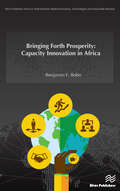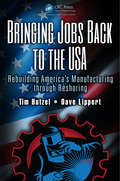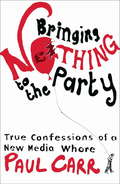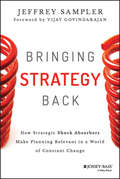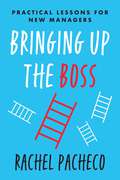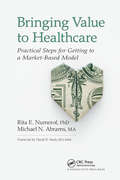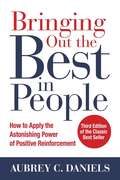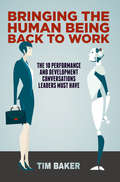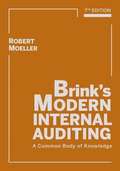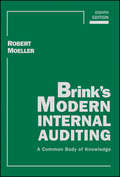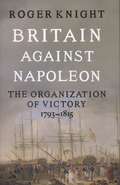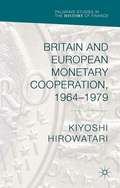- Table View
- List View
Bringing Forth Prosperity: Capacity Innovation in Africa
by Benjamin BoboPath to Capacity Innovation: An Africa-MNC Strategic Alliance, a policy framework is advanced proposing a strategic alliance between African countries -represented by NEPAD- and the multinational corporation with input from the NGO and couched upon an NEPAD-MNC-NGO cross-fertilizing integrative structure. Capacity innovation is the key to Africa's transformation: with the appropriate catalysts, innovation and transformation are but a matter of time in gestation. The first of two major catalysts necessary to prompting this change so long sought by Africans came at the adoption of the New Partnership for Africa's Development. It is one of the most profound collaborations of African Heads of State. The second catalyst is proposed in this work in the form of the multinational corporation as change agent for the innovation process working in alliance with NEPAD as Africa's spokesperson for innovation. The policy framework for African capacity innovation is the material product along with discourse for redress of corruption and security policy narrative for protecting the assets of multinational corporations.Bringing Forth Prosperity: Capacity Innovation in Africa questions capital theory as a development construct and an appropriate platform upon which sustained capacity innovation in Africa may emerge; explores Africa's road to modernity in the context of selected development constructs and assesses capacity innovation from a top down-bottom up perspective purposely to serve as backdrop to the Africa-MNC strategic alliance framework; constructs country capacity ID to identify internal resources available to African countries to support capacity innovation; conceptualizes the Africa-MNC strategic alliance to convey a capacity innovation philosophy; articulates an African capacity innovation policy framework to guide the Alliance through a series of actions designed to prompt innovation activity and set the continent on a course to sustained transformation; and articulates a scheme to protect assets -human and physical- derived through the Africa-MNC strategic alliance.
Bringing Groups Together: The Politics of Africa and Elsewhere
by Robert I. RotbergWhen experienced African political figures came together for the first time in 2003 explicitly to strengthen leadership on the continent, they did so in an atmosphere of crisis. The Congo, the Sudan, and Zimbabwe (not to mention other nations) were each suffering from massive and prolonged leadership failures. What could be done? Could the quality of leadership in Africa be strengthened? Could the glaring deficits in intergroup leadership across the sub-Saharan African region be remedied? Could responsible leadership be taught as a skill set and could those skills be transferred to those African countries where leadership was most lacking? In this chapter, the author examines models of effective and ineffective intergroup leadership and nation building as he details the African Leadership Council's efforts to redress the failures of leadership in Africa. This chapter was previously published as chapter 12 of "Crossing the Divide: Intergroup Leadership in a World of Difference."
Bringing Jobs Back to the USA: Rebuilding America's Manufacturing through Reshoring
by Tim Hutzel Dave LippertA follow-up to Tim Hutzel's previous book, Keeping Your Business in the USA: Profit Globally While Operating Locally, this book tells the stories of companies that have sent their jobs outside of the USA and the negative effects this had on the quality of their products and services, employees, supply chain providers, and consumers.Bringing Jobs Ba
Bringing Law Home: Gender, Race, and Household Labor Rights (Articulations: Studies in Race, Immigration, and Capitalism)
by Katherine Eva MaichThe personal nature of domestic labor, and its location in the privacy of the employer's home, means that domestic workers have long struggled for equitable and consistent labor rights. The dominant discourse regards the home as separate from work, so envisioning what its legal regulation would look like is remarkably challenging. In Bringing Law Home, Katherine Eva Maich offers a uniquely comparative and historical study of labor struggles for domestic workers in New York City and Lima, Peru. She argues that if the home is to be a place of work then it must also be captured in the legal infrastructures that regulate work. Yet, even progressive labor laws for domestic workers in each city are stifled by historically entrenched patterns of gendered racialization and labor informality. Peruvian law extends to household workers only half of the labor protections afforded to other occupations. In New York City, the law grants negligible protections and deliberately eschews language around immigration. Maich finds that coloniality is deeply embedded in contemporary relations of service, revealing important distinctions in how we understand power, domination, and inequality in the home and the workplace.
Bringing Leadership to Life in Health: A New Perspective
by Graham Dickson Bill ThollGlobally, the health sector faces significant demands for reform and improvement to meet the needs of the 21st Century. To achieve that goal, highly sophisticated and capable leaders are required across all dimensions of the health system. This book describes the key challenges that demand reform, why better leadership is the source code for better system performance, and the issues that stand in the way of getting that leadership. It includes substantive treatment of the modern democratic challenges that healthcare leaders face; and the essence of what it means to be a leader in today's world. The essence of leadership itself is described, and the case made for the need for people to use the workplace as the place to develop leadership rather than relying solely on formal programs. It will also outline a self-directed learning process that any individual leader--citizen, clinician, or senior executive--can use to develop their own leadership capability, and thus become more active as a leader of change. This book addresses the need for leaders to think on a system-wide scale. A second part of the book focuses primarily on the Canadian Health system and LEADS in a Caring Environment capabilities framework, and the link between LEADS and frameworks in Australia and the UK. LEADS was developed through a partnership between members of the Healthcare Leaders Association of British Columbia and the Canadian College of Health Leaders, the Canadian Health Leadership Network and Royal Roads University. Currently it is stewarded by a not-for-profit collaboration that has endorsed LEADS as an evidence-informed set of national expectations for Canadian health leaders. LEADS has been endorsed by many health organizations in almost all provinces in Canada as a foundation for their talent management programs in leadership (development and succession planning). The book will address the research foundations for the LEADS framework; how it was developed; the framework's contents; its congruence with other national frameworks, and how LEADS can be used as a model to envisage and plan change.
Bringing Nothing to the Party: True Confessions Of A New Media Whore
by Paul CarrA fascinating and hilarious expose of how a group of young opportunists, chancers and geniuses found instant fame and fortune by messing about on the web. And one man's attempt to follow in their footsteps.Having covered the first dot com boom, and founded a web-to-print publishing business during the second one, Paul counts many of the leading Internet entrepreneurs amongst his closest friends. These friendships mean he doesn't just attend their product launches and press conferences and speak at their events, but also gets invited to their ultra-exclusive networking events, and gets drunk at their parties.Paul has enjoyed this bizarre world of excess without having to live in it. To help the moguls celebrate raising millions of pounds of funding without having to face the wrath of the venture capitalists himself. But in 2006, Paul decided he didn't want to be a spectator any more. He had been harbouring a great dot com project of his own and decided it was time to do something about it.
Bringing Silicon Valley Inside
by Gary HamelIn 1998, Silicon Valley companies produced 41 IPOs, which by January 1999 had a combined market capitalization of $27 billion--that works out to $54,000 in new wealth creation per worker in a single year. Multiply the number of employees in your company by $54,000. Did your business create that much new wealth last year? Half that amount? It's not a group of geniuses generating such riches. It's a business model. In Silicon Valley, ideas, capital, and talent circulate freely, gathering into whatever combinations are most likely to generate innovation and wealth. Unlike most traditional companies, which spend their energy in resource allocation--a system designed to avoid failure--the Valley operates through resource attraction--a system that nurtures innovation. In a traditional company, people with innovative ideas must go hat in hand to the guardians of the old ideas for funding and for staff. But in Silicon Valley, a slew of venture capitalists vie to attract the best new ideas, infusing relatively small amounts of capital into a portfolio of ventures. And talent is free to go to the companies offering the most exhilarating work and the greatest potential rewards. It should actually be easier for large, traditional companies to set up similar markets for capital, ideas, and talent internally. After all, big companies often already have extensive capital, marketing, and distribution resources, and a first crack at the talent in their own ranks. And some of them are doing it. The choice is yours--you can do your best to make sure you never put a dollar of capital at risk, or you can tap into the kind of wealth that's being created every day in Silicon Valley.
Bringing Strategy Back
by Jeffrey L. SamplerReconsider Strategy and Make Planning RelevantIn Bringing Strategy Back, strategy expert Jeffrey Sampler cuts through the clutter to reveal exactly why the usual tools of strategy are so sorely out of sync with our needs: windows of opportunity close far faster than they once did, many of these opportunities are smaller than they once were, growth rates are uneven across markets, and today's competition is more asymmetrical than ever. The upshot for managers is that they need to reorient their approach to absorb the shocks and surprises that strike at a moment's notice. Only then can strategic planning reliably play its part.Leaders all around the world at organizations of any size and type will benefit by shedding their obsolete notions about strategy and becoming more resilient. Bringing Strategy Back rises to the challenge and presents a new prescriptive model. It introduces four "strategic shock absorbers" that enable leaders to build resilient organizations that can withstand even the most unexpected global turbulence. Based on the author's in-depth research in the world's most tempestuous markets, the model delivers several must-have qualities that interact and work together in an ongoing process: Accuracy, Agility, Momentum, and Foresight. With this new framework, Bringing Strategy Back shows how to be prepared and proactive, rather than reactive, even when the future is uncertain.
Bringing Up the Boss: Practical Lessons for New Managers
by Rachel PachecoAXIOM BUSINESS BOOK AWARD SILVER MEDALIST — HUMAN RESCOURCES / EMPLOYEE TRAINING Managing is hard. Managing for the first time is even harder. First-timers want to quickly learn what it takes to be a successful manager—like they learned how to code, how to design, how to sell—and put those learnings into practice. But what does it mean to manage, and how do you teach someone to be a good manager? Enter Rachel Pacheco, an expert at helping start-ups solve their management and culture challenges. Pacheco, a former chief people officer and founding team executive at multiple start-ups, conducts research on management and works with CEOs and their managers to build the skills necessary to navigate a rapidly scaling organization. In Bringing Up the Boss: Practical Lessons for New Managers, you&’ll learn how to give effective feedback, how to motivate your team members, and how to hire and fire well, among many other critical management skills. You&’ll also learn what it means to manage yourself in this new role, and how to navigate the often awkward and sometimes challenging situations that arise in this new position. Pacheco shares what makes a manager great, along with anecdotes, research, tools, and how-to's that help overwhelmed employees become expert managers fast.
Bringing Value to Healthcare: Practical Steps for Getting to a Market-Based Model
by Michael Abrams Rita E. NumerofIn Bringing Value to Healthcare: Practical Steps for Getting to a Market-Based Model, Rita Numerof and Michael Abrams lay out the roadmap to a healthcare system that is accountable for delivering optimal patient outcomes at a sustainable cost. This is the handbook for payer, provider, pharmaceutical, and medical device executives seeking to preserve today‘s profitability while positioning their organizations for success in the very different markets of tomorrow. The book‘s guidance is illuminated by case studies and each chapter concludes with a self-assessment tool and key questions.
Bringing out the Best In People: How To Apply the Astonishing Power of Positive Reinforcement
by Aubrey C. DanielsMaximize employee performance with this updated edition of the classic bestseller <P><P> In Bringing Out the Best in People: How to Apply the Astonishing Power of Positive Reinforcement, renowned thought leader and internationally recognized workplace expert Aubrey Daniels takes a look at today’s rapidly changing work environment, providing a timely update to his seminal book on performance management. <P><P> As one of the foremost speakers and writers in the human performance field, for nearly 40 years Daniels has worked with organizations to apply scientifically-based behavioral tools and principles to effectively address workplace issues―particularly as they relate to management, leadership, culture, innovation, safety, engagement, and collaboration. <P><P> Bringing Out the Best in People: How to Apply the Astonishing Power of Positive Reinforcement, presents Daniels’ proven strategies that have been successfully adopted by hundreds of organizations worldwide―ranging from start-ups to Fortune 100 companies―and delivers step-by-step instruction and positive practices to help you implement and sustain positive change. <P><P> With a behavioral foundation and new chapters on employee engagement and the impact of the exponential increase in technology, this latest edition features all new examples, updated approaches to effective recognition and rewards systems, tips for stimulating and fostering innovation and creativity, and productive ways to embrace and empower the multi-generational workforce, including Millennials and future generations. <P><P> This timely update tackles the changes in the contemporary work environment, while providing step-by-step instructions and proven practices that have been adopted by Daniels’ global clients, from startups to Fortune 100 companies. Learn how to: <P> • Create effective recognition and rewards systems that are positively reinforcing to employees <P>• Stimulate innovation and creativity in exciting new ways <P>• Understand fluency as an efficient way to reduce training costs and increase training effectiveness for all employees <P>• Engage employees in ways that lead to improved performance and a stronger culture <P>• Motivate and empower the multi-generational workforce <P>• Understand and shape how technology is affecting employee behavior―for better and worse
Bringing the Human Being Back to Work: The 10 Performance And Development Conversations Leaders Must Have
by Tim BakerFor the past 100 years, we’ve progressively dehumanized our places of work. We’ve learned to systemize, homogenize, and mechanize – all in the quest for greater efficiency and cost-saving. We’ve forgotten that the human being is the centre of work. This book highlights the ten essential performance and development conversations leaders must have to restore human spirit at work. First, it explains the importance of cultivating an authentic workplace by resisting the dumbing down of work and respecting employee dignity. Second, it presents five developmental conversations, from coaching to relationship-building. Third, it outlines five performance conversations, from climate review to innovation. An organization – any organization – is a group of people working together towards a common goal, but we tend to lose sight of this simple idea. Too often, human resources are lumped in with technological resources, administrative resources and financial resources. Managers become obsessed with processes, procedures and systems. Tim Baker provides leaders with a roadmap to bring the human being back to work.
Bringing the Soul Back to Marketing: Proceedings of the 2023 AMS World Marketing Congress, Canterbury, UK, July 11–14, 2023 (Developments in Marketing Science: Proceedings of the Academy of Marketing Science)
by Juliann Allen Vincent JeseoThe “soul” centers our activities and inspirations. The body of marketing changes shape rapidly; however, we should not lose sight of its “soul”. This volume focuses on preserving the “soul” of marketing in a data-driven world where technology has proliferated amidst a myriad of global challenges. Featuring papers presented at the 2023 Academy of Marketing Science World Marketing Congress held in Canterbury, UK, this book explores ideas, theories and practices to tackle global and economic challenges in marketing and emphasize marketing's contribution to business and society at large, further strengthening the academic community.Founded in 1971, the Academy of Marketing Science is an international organization dedicated to promoting timely explorations of phenomena related to the science of marketing in theory, research, and practice. Among its services to members and the community at large, the Academy offers conferences, congresses, and symposia that attract delegates from around the world. Presentations from these events are published in this Proceedings series, which offers a comprehensive archive of volumes reflecting the evolution of the field. Volumes deliver cutting-edge research and insights, complementing the Academy’s flagship journals, the Journal of the Academy of Marketing Science (JAMS) and AMS Review.
Brink's Modern Internal Auditing
by Robert R. MoellerToday's internal auditor is responsible for creating higher standards of professional conduct and for greater protection against inefficiency, misconduct, illegal activity, and fraud. Now completely revised and updated, Brink's Modern Internal Auditing, Seventh Edition is a comprehensive resource and reference book on the changing world of internal auditing, including new coverage of the role of the auditor and internal control. An invaluable resource for both the new and seasoned internal auditor, the Seventh Edition provides auditors with the body of knowledge needed in order to be effective.
Brink's Modern Internal Auditing: A Common Body of Knowledge (Wiley Corporate F&A)
by Robert R. MoellerThe complete guide to internal auditing for the modern world Brink's Modern Internal Auditing: A Common Body of Knowledge, Eighth Edition covers the fundamental information that you need to make your role as internal auditor effective, efficient, and accurate. Originally written by one of the founders of internal auditing, Vic Brink and now fully updated and revised by internal controls and IT specialist, Robert Moeller, this new edition reflects the latest industry changes and legal revisions. This comprehensive resource has long been—and will continue to be—a critical reference for both new and seasoned internal auditors alike. Through the information provided in this inclusive text, you explore how to maximize your impact on your company by creating higher standards of professional conduct and greater protection against inefficiency, misconduct, illegal activity, and fraud. A key feature of this book is a detailed description of an internal audit Common Body of Knowledge (CBOK), key governance; risk and compliance topics that all internal auditors need to know and understand. There are informative discussions on how to plan and perform internal audits including the information technology (IT) security and control issues that impact all enterprises today. Modern internal auditing is presented as a standard-setting branch of business that elevates professional conduct and protects entities against fraud, misconduct, illegal activity, inefficiency, and other issues that could detract from success. Contribute to your company's productivity and responsible resource allocation through targeted auditing practices Ensure that internal control procedures are in place, are working, and are leveraged as needed to support your company's performance Access fully-updated information regarding the latest changes in the internal audit industry Rely upon a trusted reference for insight into key topics regarding the internal audit field Brink's Modern Internal Auditing: A Common Body of Knowledge, Eighth Editionpresents the comprehensive collection of information that internal auditors rely on to remain effective in their role.
Brita Products Co.
by John DeightonClorox's Brita skillfully exploits a tide of water safety concerns, growing a home water (filtration) business from inception to a 15% U.S. household penetration in ten years. The dilemma in the case arises as the period of increasing returns seems to be drawing to a close, and management must use its legacy, an installed based and a strong brand equity, to take the business forward into a less friendly environment. Students can model the relation between the primary demand for pitchers and the derived demand for filters to decide where they want to put future investments.
Britain Against Napoleon: The Organisation of Victory, 1793-1815
by Roger KnightFor more than twenty years after 1793, the French army was supreme in continental Europe. Only at sea was British power dominant, though even with this crucial advantage the British population lived under fear of a French invasion for much of those two decades. How was it that, despite multiple changes of government and the assassination of a Prime Minister, Britain survived and eventually won a generation-long war against a regime which at its peak in 1807 commanded far greater resources and manpower? There have been innumerable books about the battles, armies and navies of the French Revolutionary and Napoleonic Wars. This book looks beyond the familiar exploits (and bravery) of the army and navy to the politicians and civil servants, and examines how they made it possible to continue the war at all. It shows the degree to which, because of the magnitude and intensity of hostilities, the capacities of the whole British population were involved- industrialists, farmers, shipbuilders, cannon founders, gunsmiths and gunpowder manufacturers all had continually to increase quality and output as the demands of the war remorselessly grew. Knight show that the intelligence war was also central- and that despite a poor beginning to both gathering and assessment Whitehall's methods steadily improved. No participants were more important, he argues, than the bankers and international traders of the City of London, who played a critical role in financing the wars and without whom the armies of Britain's allies could not have taken the field. Knight demonstrates that despite these extraordinary efforts, between 1807 and 1812 Britain came very close to losing the war against Napoleon - not through invasion (though the danger until 1811 was very real) but through financial and political exhaustion. The Duke of Wellington famously said that the battle which finally defeated Napoleon was 'the nearest run thing you ever saw in your life'- this book shows how true that was for the Napoleonic War as a whole. Praise for The Pursuit of Victory- The Life and Achievement of Horatio Nelson 'The only complete and fully scholarly life of Nelson ever to have been published . . . an authority which none of his rivals can match. ' N. A. M. Rodger, The Times Literary Supplement 'The best Life of Nelson that we are ever likely to see. ' Geoffrey Moorhouse, Guardian 'Magisterial . . . almost every page contains an intriguing insight into Britain's greatest maritime hero . . . the accounts of major actions - Cape St Vincent, Santa Cruz, the Nile, Copenhagen and Trafalgar - are as exciting as any I've read. ' Andrew Roberts, Mail on Sunday 'Superb . . . stunning . . . a picture of the most vivid humanity. ' Simon Heffer, Literary Review 'There is every reason to think that this superb work will become the definitive Nelson biography. ' Economist 'A magnificent biography. ' Tom Pocock, Spectator 'Knight returns the Hero of England to us as a man. ' Flora Fraser, Daily Telegraph
Britain At Work: As Depicted by the 1998 Workplace Employee Relations Survey
by Gill Dix Mark Cully Andrew OreillyBritain at Work presents a detailed analysis of the 1998 Workplace Employee Relations Survey, the largest survey of its kind ever conducted.
Britain Under Protection: An Examination of the Government's Protectionist Policy (Routledge Library Editions: International Trade Policy #3)
by Ranald M. FindlayWhen this book was published in 1934, Britain had been a protectionist country for three years. The Import Duties Act and the Ottawa Agreements were based upon four main principles – the use of the tariff as an instrument of revenue, its use as a bargaining weapon, its use as a means of protecting domestic manufacturers, and its use as a means of fostering trade within the British Empire. This book is a valuable analysis of the years of protectionism, measuring the effects on the country’s trade and economy.
Britain and America, 1850–1939: A Study of Economic Change (Routledge Revivals)
by G. E. Mingay Philip S. BagwellFirst published in 1970, Britain and America 1850–1939 is a key text for anyone seeking to trace and interpret the development of the two great trans-Atlantic economies.The authors present a comparative survey of the economic development of Britain and America. The book compares and contrasts the economic and social progress of the two countries in the period of rapid industrialization and dramatic social change between 1850 and 1939. Throughout, the authors explain the interaction of the two economies upon each other and give reasons – social and political as well as economic – for the outstanding differences in the economic life of the two countries. Separate chapters give a comprehensive account of agriculture, transport, trade unions, banking, overseas trade, industry, and social problems. Among the individual topics considered are the economic significance of the Civil War, the influence of the railways, migration of labour and export of capital, the retardation of the British economy, the great slump of the 1930s and the New Deal. The authors support their arguments with numerous statistical tables, charts, and diagrams. This book will be of interest to students and researchers of economics and history.
Britain and European Monetary Cooperation, 1964-1979 (Palgrave Studies in the History of Finance)
by Kiyoshi HirowatariThe collapse of the Bretton Woods system in the early 1970s resulted in a transition to fluctuating rather than fixed currency system. This brought sterling into the turmoil of the world currency markets, and by the end of the 1970s, sterling had quietly ended its role as an international currency. Sterling-dollar diplomacy collapsed, bringing to an end what had hitherto been considered Britain's prime relationship. Britain and European Monetary Cooperation, 1964-1979 provides a unique perspective on these events, shedding light on the complexities of the historical context of British monetary diplomacy and exploring the country's attempt at a European approach to sterling in the 1960s and '70s. The book describes the political and economic approach Britain took at the turn of the 1970s, and explains how the country became restricted by the burden of the sterling balances. In this book, the author illustrates how these developments offered opportunity for both cooperation and conflict in the light of monetary diplomacy. He demonstrates how Britain's struggle to achieve exchange rate stability, twinned with controversy over European Economic Community membership, finally prompted serious reconsideration of economic policy-making.
Britain and Japan in the 1973 Middle East Oil Crisis: Washington’s Silent Partners (Routledge Studies in Modern History)
by Erika MillerMiller examines Britain and Japan’s involvement in the Middle East peace process after the October War of 1973 and how it contributed to the resolution of the oil crisis of 1973–74.Using important primary sources from Japan, Britain, and the United States—including recently declassified Japanese documents that had not previously been examined—this book contends that previous literature failed to address the important role of Britain and Japan and their political impact on the development in the historical events of 1973 and 1974. The two countries threw their support behind the United States, backing its policies regarding not only oil but also the Arab‑Israeli conflict. This enabled the United States to take the lead in the peace process as well as in discussions to resolve the energy crisis, which eventually led to the establishment of the International Energy Agency (IEA). Accordingly, this book challenges the accepted view that neither Anglo‑American nor US‑Japanese relations were important factors in the development of the abovementioned processes.An insightful and illuminating read for scholars of the diplomatic history of the 1970s, and especially the complex web of tensions spanning from the Arab‑Israeli conflict and between Arab oil‑producing countries and developed consumer countries.
Britain and the Crisis of the European Union
by David Baker Pauline SchnapperThis book centres on the effects of the political and later economic crisis which seriously affected the European Union and its impact on the seemingly endless UK debate over Britain's position within the EU.
Britain and the Economic Problem of the Cold War: The Political Economy and the Economic Impact of the British Defence Effort, 1945-1955 (Modern Economic and Social History)
by Till GeigerMany accounts of British development since 1945 have attempted to discover why Britain experienced slower rates of economic growth than other Western European countries. In many cases, the explanation for this phenomenon has been attributed to the high level of defence spending that successive British post-war governments adhered to. Yet is it fair to assume that Britain's relative economic decline could have been prevented if policy makers had not spent so much on defence? Examining aspects of the political economy and economic impact of British defence expenditure in the period of the first cold war (1945-1955), this book challenges these widespread assumptions, looking in detail at the link between defence spending and economic decline. In contrast to earlier studies, Till Geiger not only analyses the British effort within the framework of Anglo-American relations, but also places it within the wider context of European integration. By reconsidering the previously accepted explanation of the economic impact of the British defence effort during the immediate post-war period, this book convincingly suggests that British foreign policy-makers retained a large defence budget to offset a sense of increased national vulnerability, brought about by a reduction in Britain's economic strength due to her war effort. Furthermore, it is shown that although this level of military spending may have slightly hampered post-war recovery, it was not in itself responsible for the decline of the British economy.
Britain and the Political Economy of European Military Aerospace Collaboration, 1960–2023 (Elements in Defence Economics)
by Keith HaywardThe UK has been collaborating with international, primarily European partners in the design, development and production of advanced combat aircraft for over sisty years. Driven by a combination of rising costs and limited domestic markets, collaboration has also been a highly political act involving a combination of national, industrial and technological interests. Over the years, the form of collaboration has evolved, in some cases leading to the creation of transnational companies. The UK has been a pioneer of globalisation in the defence industry, establishing a strong presence inside the US defence market and has become a significant partner with American companies in key military aerospace programmes. This has contributed to divisions within the European military aerospace industry which are likely to continue into the next generation of combat aircraft.
